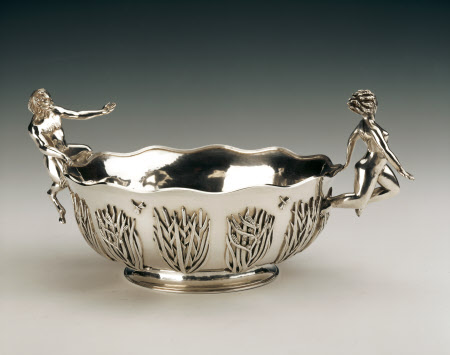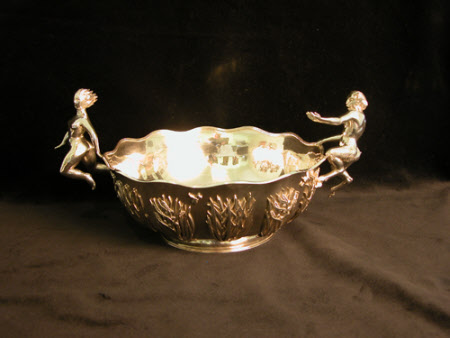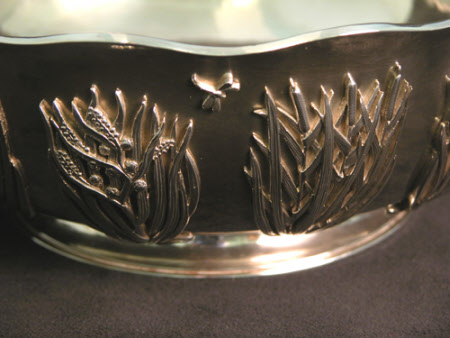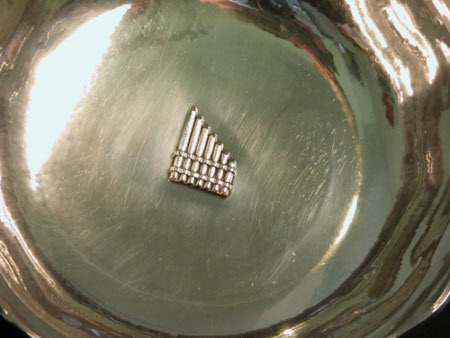Bowl
Leslie Durbin (1913 - 2005)
Category
Silver
Date
1952 - 1953
Materials
Silver, sterling
Measurements
14.3 x 31.3 x 21.7 cm; 1667 g (Weight)
Place of origin
London
Order this imageCollection
Anglesey Abbey, Cambridgeshire
NT 516491
Summary
A large bowl with handles modelled as Pan and Syrinx, silver (sterling), mark of Leslie Durbin, London, 1952/3. The low hemispherical bowl is raised from sheet silver and stands on an applied everted collet foot with a narrow applied foot ring. The sides are applied with six dragonflies flying above twelve cast and chased bunches of bullrushes alternating with reeds. A narrow reeded border is applied round the wavy rim. Inside the bowl a small set of cast pan pipes is applied to the base. The large handles are cast in the form of Pan and Syrinx. Pan is depicted climbing over the edge of the bowl with one arm outstretched towards the nymph, who appears to be pushing away from the bowl as she flees in terror. Heraldry: None Scratch weight: None
Full description
NOTE ON SYRINX AND PAN In the Metamorphoses, the Roman poet Ovid retells the classical Greek story of Syrinx, a beautiful wood nymph known for her chastity. When pursued by the amorous god Pan, she ran to the river’s edge, where she begged to the water nymphs to save her. They transformed her into hollow water reeds. Pan discovering that he was holding nothing but marsh reeds, cut them to fashion into the first set of panpipes, so that he might always have Syrinx with him. Since then all panpipes create a haunting sound when blown. NOTE ON LESLIE DURBIN Leslie Durbin (1913-2005) was one of Britain’s finest silversmiths of the 20th century, making objects as varied as processional crosses, maces, tableware, flatware, art medals, and designing coins for the Royal Mint. He also had an extraordinarily long career, starting at the age of thirteen when he won a London County Council Trade Scholarship to study silversmithing at the Central School of Arts & Crafts (CSAC), and working well into his eighties. In 1929 he was apprenticed to Omar Ramsden. Despite being a fantastic opportunity for the young Durbin, he was dismayed to learn that he was to be trained as a ‘chaser, engraver and decorator of precious metals’. Indeed he was so determined to learn all the skills of the silversmiths’ trade that he continued his education at the CSAC by attending lessons after work. In 1938 Durbin won the Goldsmiths’ Company’s competition to design altar plate for Guildford Cathedral, which he made with five colleagues from the Central School. Displayed at the Company’s exhibition of modern silverware, it was seen by 37,755 visitors including Queen Mary, who was presented by Lord Baldwin, the Prime Minister, with a gift for her 12-year-old granddaughter, Princess Elizabeth, the future Queen of Great Britain. The gift, a casket with a finial of gambolling lambs, was designed and made by Durbin. Following the siege of Stalingrad, King George VI wished to honour its citizens for their heroism in defence of their city. A presentation sword was designed by RMY Gleadowe who, finding his usual firm of silversmiths occupied with war work, asked the young Durbin to make the piece. It was exhibited at the Victoria and Albert Museum and taken on a tour of fifteen British cities before being presented to Joseph Stalin by Winston Churchill in Tehran in November 1843. British Paramount’s film of Durbin making the sword in his workshop was widely shown and it is interesting to conjecture whether Lord Fairhaven, who acquired little contemporary silver, was prompted to acquire this bowl after seeing the film, or because he had seen Durbin’s work in the royal residences. Durbin went on to receive major commissions from around the world, including for the royal family. His work has been, and continues to be, displayed in numerous exhibitions. Jane Ewart, 2025
Provenance
(Urban) Huttleston Rogers Broughton, 1st Baron Fairhaven (1896-1966) bequeathed by Lord Fairhaven to the National Trust along with the house and the rest of the contents National Trust
Credit line
Anglesey Abbey, the Fairhaven Collection (National Trust)
Marks and inscriptions
On the underside of the base: Hallmarks: ‘LGD’ (Leslie Durbin*), leopard’s head (London), ‘S’ (1953/4), lion passant (sterling), and Queen’s head (Coronation mark) *Rosemary Ransome Wallis: Treasures of the Twentieth Century: silver jewellery and art medals from the 20th Century Collection of the Worshipful Company of Goldsmiths, 2000, p 179 On the inside of the flange: Current NT Inventory Number: '516491'
Makers and roles
Leslie Durbin (1913 - 2005), goldsmith



